ISSN ONLINE(2278-8875) PRINT (2320-3765)
ISSN ONLINE(2278-8875) PRINT (2320-3765)
M. Chandran1, S. Ravindra kumar2 Dr. P. Somasundaram3
|
| Related article at Pubmed, Scholar Google |
Visit for more related articles at International Journal of Advanced Research in Electrical, Electronics and Instrumentation Engineering
Supply security, energy efficiency and growing environmental concern are the main reasons that resulted in significant penetration of Distributed Generation (DG) in the distribution system. Recent developments of connecting distributed generators to the distribution networks alter the performance of the network, particularly in islanded mode. The complexity in the protection is that the fault current seen by the protective devices would appreciably change when the system is working in grid-connected mode and islanded mode. These small generators have the advantage of being connected to the nearby load centre. This paper presents an algorithm to protection coordination of distribution network with DGs. The algorithm uses the communication feasibility available with the modern relays. In addition, a smart approach is proposed with GOOSE (Generic Object Oriented Sub-station Event) communication, to enable introduction of sophisticated Logic schemes for distribution system.
Keywords |
| distribution system, distributed generation, islanding, adaptive over current co-ordination, GOOSE. |
INTRODUCTION |
| Increase of demand, concern about environment and benefit of on-site generation has helped the penetration of DG instead of usual distribution, in a great way. Even though this has given some operational challenges, the advantages are the environmental benefits and ability of the system to get supply in the case of grid failure in the islanding mode. The major protection problem, emerges during the proliferation of DG in the distribution system, is the poor coordination issue due to the grid connected mode and island mode. The protection system should ensure that, sensitivity is not compromised and still be selective enough to isolate the faulty zone from the system. |
| For the distribution companies, islanding operation can improve the overall security of the power supply. The issues related to state detection (grid connected or island), control of frequency, under frequency load shedding, over current protection and grounding are analysed in [1]. Potential protection problems associated with the interconnection of dispersed storage and generation (DSG) devices to the distribution system are dealt in [2]. DG in distribution has some effect in fuse-to-fuse co-ordination and relay-to-relay co-ordination [3]. It has been shown through an example that fault currents through the protective devices would change after the introduction of DG [4]. An adaptive scheme for coordination between fuses and between fuses and reclosers, which is independent of size, number and placement of DG in distribution system has been proposed in [5]. Various research papers [6–11] analyse the merits / demerits of different approaches in the adaptive protection concept. An expert system for protective device co-ordination in the presence of small power procedures has been presented in [12]. Literatures reveal the presence of many such intelligent programs. A hybrid detection technique has been proposed in [13] to identify the islanding or tripping of any breaker in the system with DG based on the communication between utility and DGs. The technique involves the passive method of analysing the rate of voltage change and active method of real power shift for detection of islanding scheme. |
| The traditional over current coordination methodology used in radial systems is based on TCCs. Both downstream and upstream protective devices should be able to detect the over current presence, with the downstream device operating faster than the upstream one. Thus, the TCC corresponding to the downstream device must be located below and to the left of the upstream curve, keeping a narrow area of tolerance between the TCCs. A methodology has been proposed in [14] to conduct over current coordination studies on distribution systems with embedded DG, which uses a program developed in Microsoft Excel, with the inputs of TCC and operating cycle. By means of GOOSE (Generic Object Oriented Sub-station Events) messaging facility available in IEC 61850 standard, the peer-to-peer communication over a sub-station-wide switched Ethernet LAN enables sophisticated logic schemes to be introduced for sub-station protection and automation [15]. |
| In order to ensure effective isolation of the fault even in island modes, where fault current seen by the relays are very less, this paper proposes an algorithm that is suitable for radial distribution system with multiple distributed generators. The algorithm uses a control processor, which gets the status from the breakers and decides the particular group of TCC to be adapted to the particular relay. Additionally, a smart approach for ensuring the fast clearing of faults, using GOOSE communication, is also proposed to have sophisticated logic scheme. |
II. PROPOSED METHODOLOGY |
| The seven-bus test system considered for the analysis is given in Figure 1, which shows a typical radial distribution feeder with related distributed generators, loads and protective devices. The model of the distribution system considered is having grid connection through a transformer at “bus-LV” and further seven buses are considered in the network with interconnections between them as shown in Figure 1. In addition to the grid supply, three gas turbine generators (GTGs) each of 1 MW rating with corresponding step up transformers are connected at bus 4, 6 and 7. Apart from these, three wind turbine generators of 630 KW each are also considered to supply power at bus 3. The whole system is simulated in such a way that, in the absence of grid, the capacity of the DG is enough to meet the demand, without a need for load shedding. In order to ensure the system voltage reliability even under islanding condition, suitable rating of capacitor banks are also considered at bus 4, 5 and the LT bus of WTGs. The WTGs are considered as induction generators running at UPF with local compensation for their VAR consumption. |
| The following assumptions are made while studying the short circuit analysis of the proposed system. |
| (i) Fuse–fuse co-ordination / fuse–relay co-ordination is already fulfilled for the base case |
| (ii) The relays considered are unidirectional. |
| The load flow results shown in Figure 2 can reveal that, the voltage levels at bus 1 to bus 7 are above the margin of 0.97 p.u even in islanded mode of operation. It may also be seen from the simulation that, the sharing of load by the GTGs are only about 30 – 40% in grid connected mode, whereas, in the island mode they are running to the optimum level to meet the demand. Being a renewable energy source, the WTGs are considered always running at rated load, as long as they are in service and wind permits. |
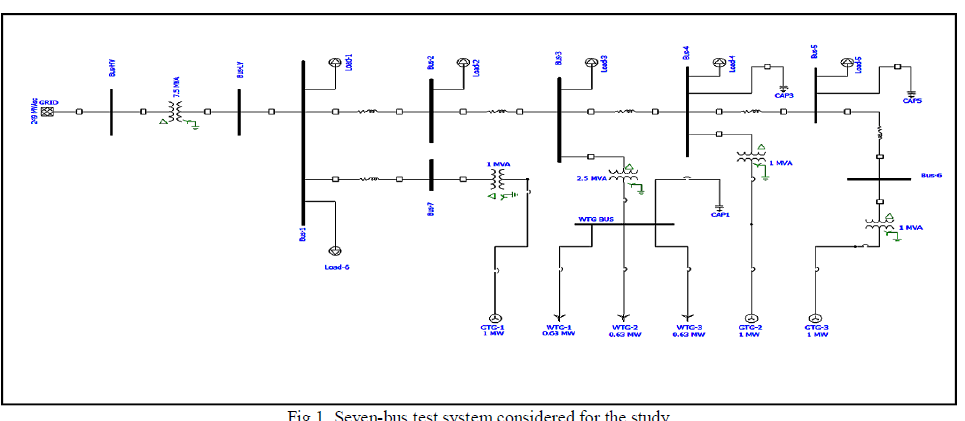 |
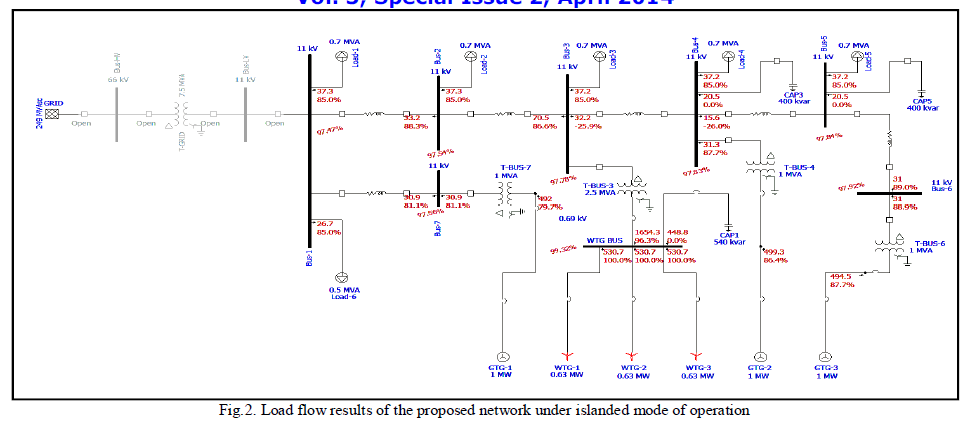 |
| With this validation, short circuit analysis was done for the proposed radial distribution network for different scenarios listed in Table I. |
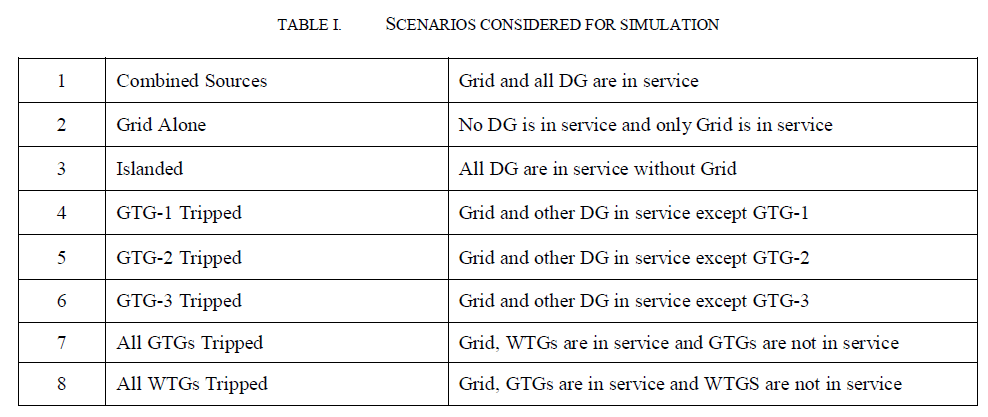 |
| The fault current seen by the respective relays for various scenarios are given in the Table II (eg. R56 represents the relay between bus 5 and bus 6 at the end of bus 5). |
| Adaptive protection method proposed is expected to function as an on-line activity that changes the “Time Current Characteristic” (TCC) group of the protection system (relay) in response to the change in the system conditions, by means of a control action. It is a well-known fact that, modern relays are capable of having multiple groups (normally 4) of TCC curves, which can be selected / adapted by external communication. The proposed adaptive algorithm is to define four groups of current settings, based on the fault currents calculated as given in the Table II for various scenarios of the DG. |
| The groupings of short circuit current seen by the protection relays for different scenarios are given in Table III. It may be seen that, four different groups are given for the relays closer to the grid / DG, where as the change in fault current is very minimum is some of the tail end relays. In such cases, only two or three groups are defined. With the groups of fault current set for each relay, based on the various scenarios, the algorithm will sense the condition of the system, based on the feedback from the breaker status, to conclude the scenario. |
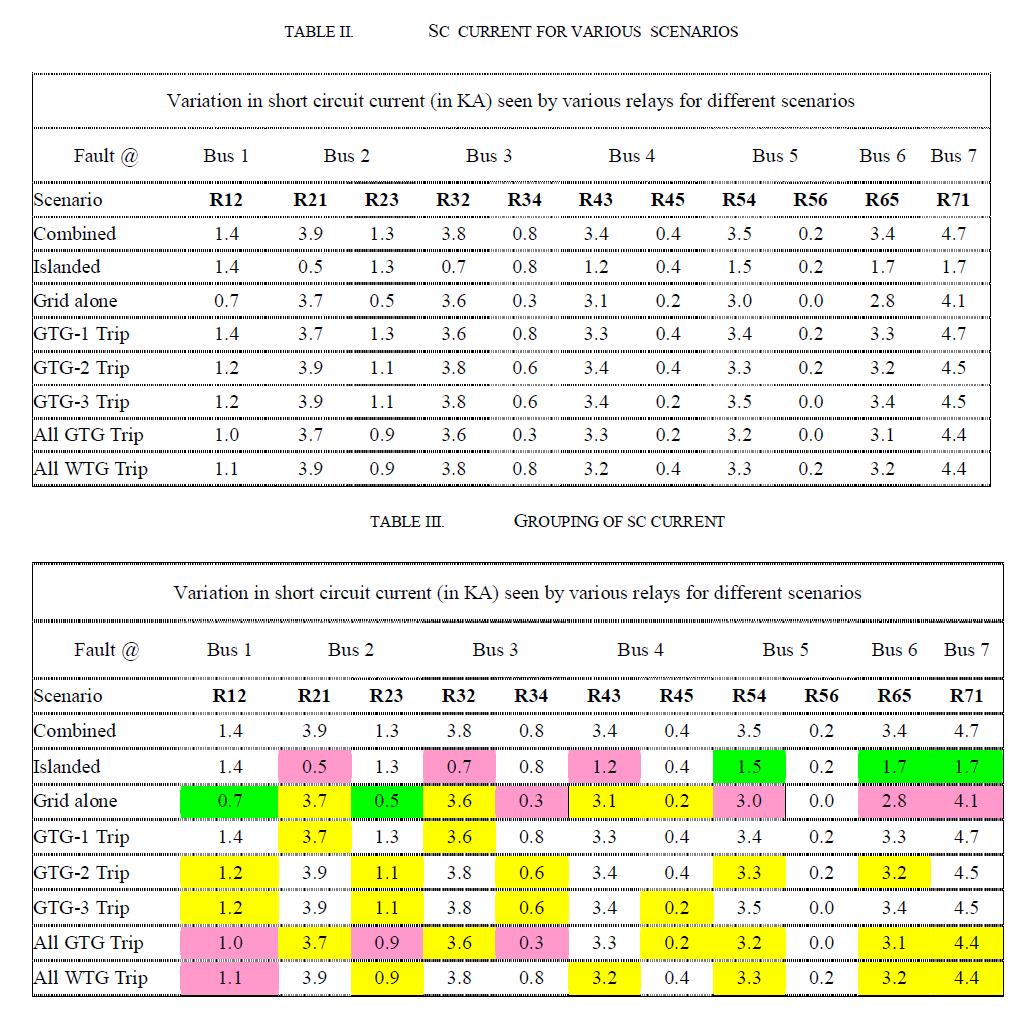 |
| The control processor, which receives the ‘ON/OFF’ status from the breakers will decide the particular group of TCC to be adapted to the particular relay. Even though much more possible combinations are theoretically possible, for the sake of simplicity and easy understanding, only some essential combinations of ‘breaker statuses’ are considered and given in the Table IV. |
 |
| A flow chart explaining the process to decide the specific group based on the breaker status is given in the Figure 3. Relay settings to be adopted for each group / status of the system is given in Table V. |
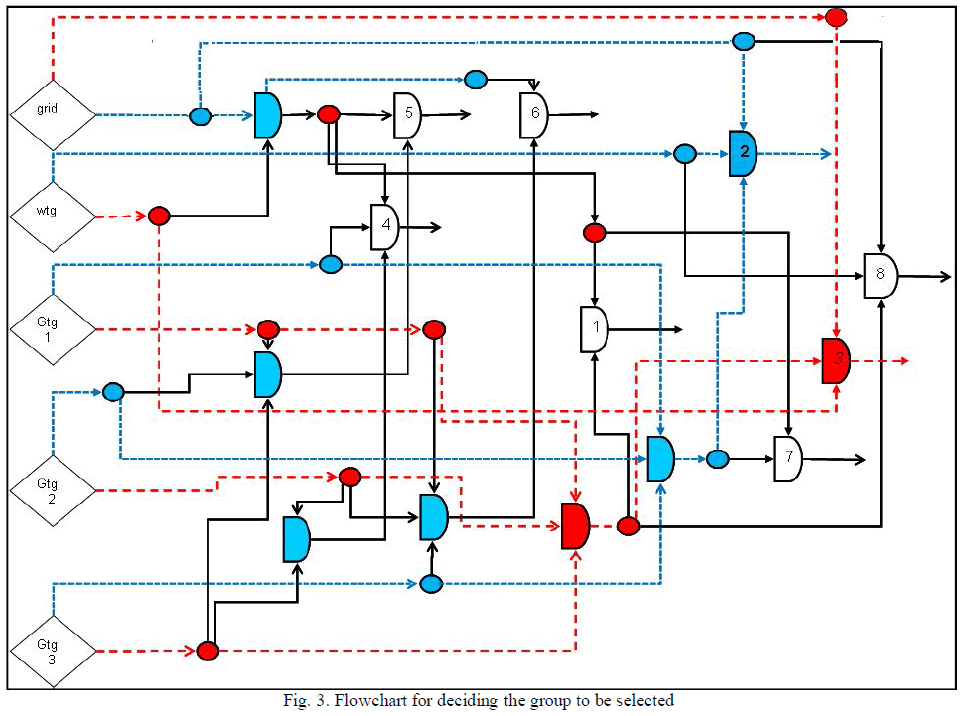 |
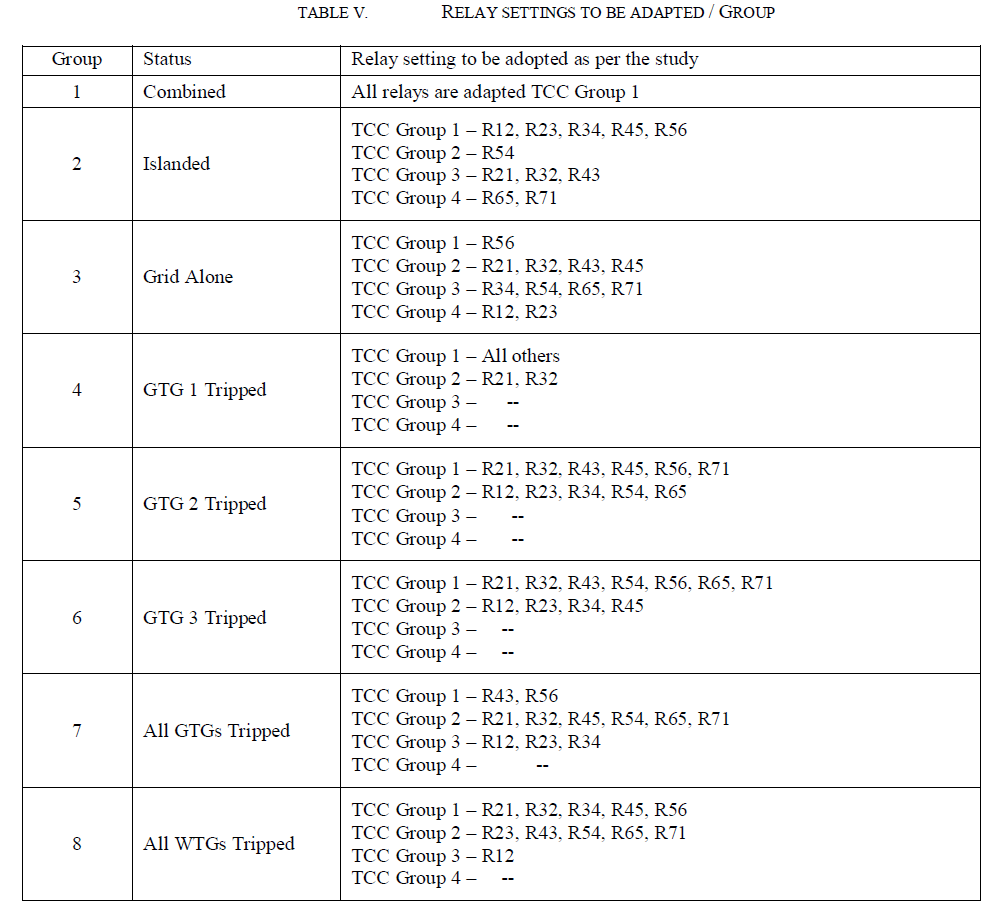 |
| The concept of pushing the trip curve dynamically, depending on the number of DER connected in the system and micro grid topology has been suggested in [16]. The relay coordination methodology proposed in this paper extends the concept of pushing the trip curve in a more realistic way in the use of field application. |
III. RESULTS AND DISCUSSIONS |
| Different group of Time Current Coordination curves are drawn for various relays using etap, adapting the proposed methodology. From the curves given in Figure 4a to 4d, it may be evident that, when the fault current seen by the relay varies according to the mode of operation, by dynamically varying the TCC of the particular relay, the relay operating time reduces considerably. Hence, the TCC groups adapted vide Table V, are ensuring the least operating time for the various breakers. |
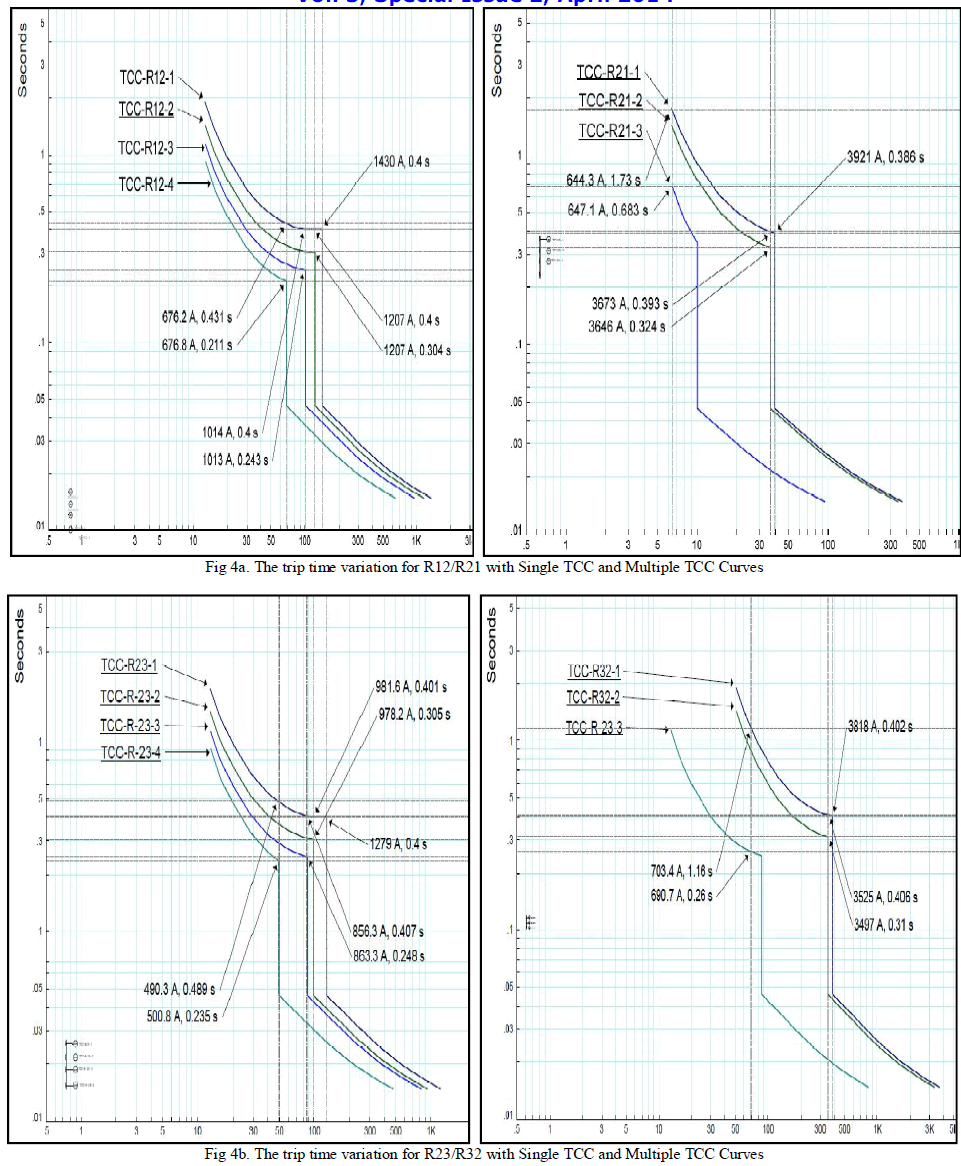 |
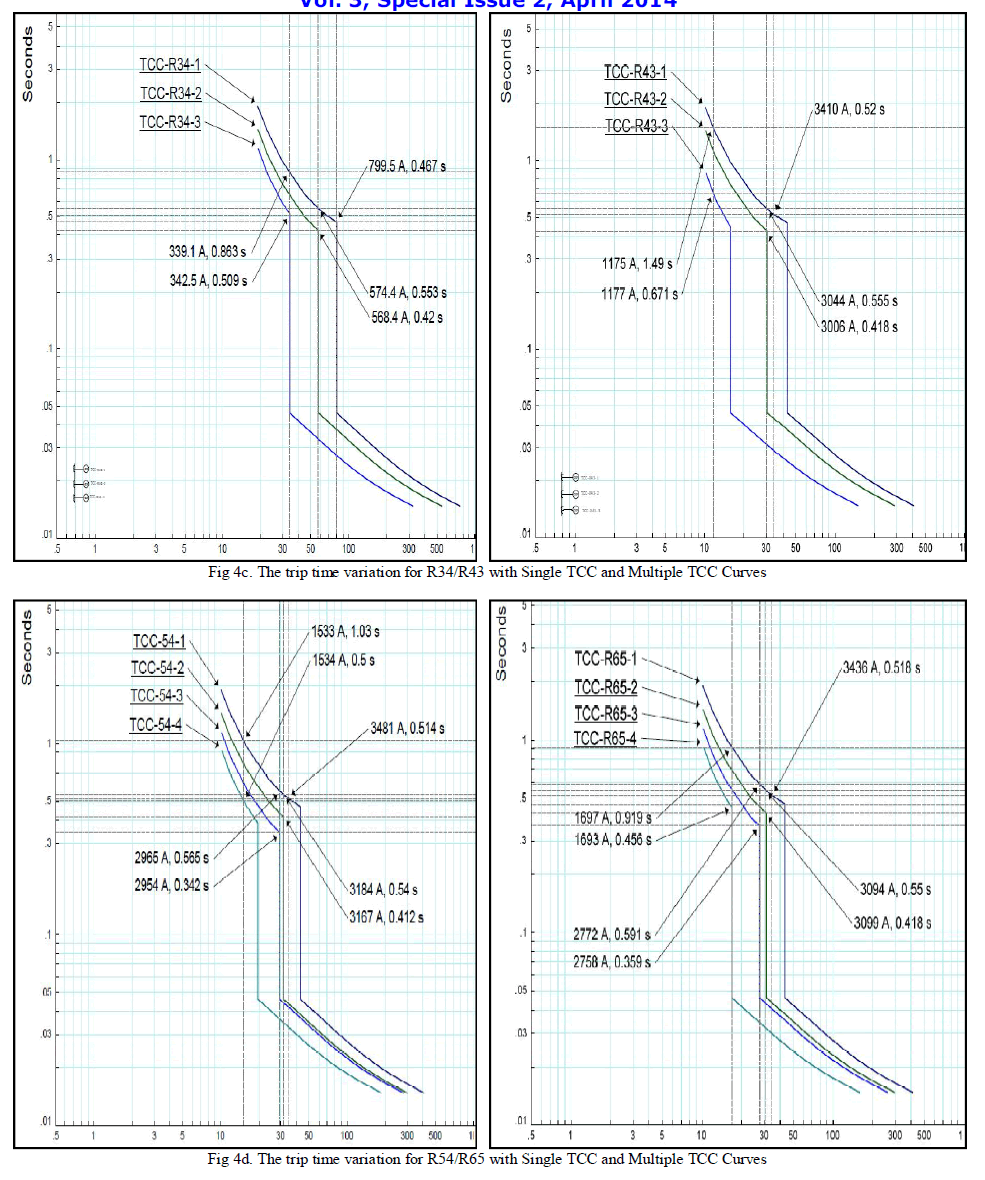 |
IV PROPOSED SMART FUNCTION USING GOOSE TECHNOLOGY |
| The grid connection with breakers / relays on the grid transformer LV bus (RLV) and between Transformer LV bus and bus-4 (RLV-1) is shown in Figure 5. Since, the transformer LV bus may have some more feeders emanating from that, fed by the Grid, to have proper co-ordination between these two breakers, the relay RLV might be set to act in coordination with the relay RLV-1, with an intentional time relay of some 400-500 ms. |
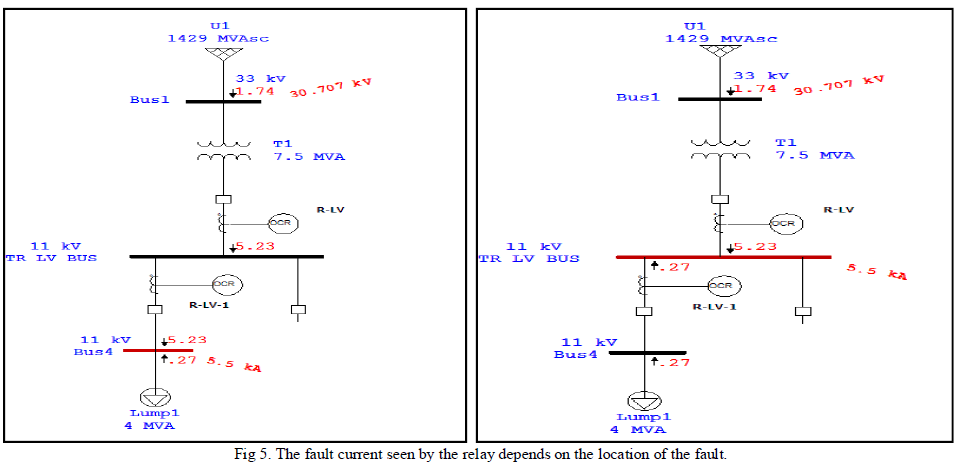 |
| When a fault is occurring at the Transformer LV bus, the fault current will not be seen by the relay RLV-1 as this relay is an unidirectional relay, and fault current contribution by the back-emf of the load is small when compared to the fault current fed by the grid. |
| In such a scenario, the co-ordination delay of 400–500 ms between the relays RLV and RLV-1 need not to be initiated, and every effort made to trip the breaker RLV at the earliest possible time, is always advantageous. |
| By using GOOSE messaging concept, as shown in Figure 6, an operational speed gain can be achieved by transferring GOOSE messages between the relays interconnected with a Local Area Network (LAN), the blocking/speed up signals can be sent directly from relay to relay without additional delay from auxiliary relays. |
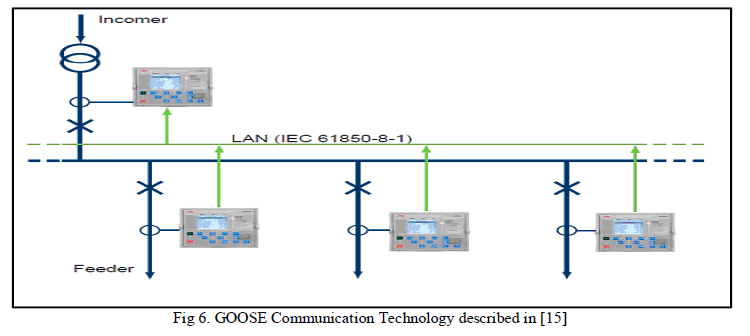 |
| Hence, with this technology, when bus-LV fault is sensed by RLV, via GOOSE communication, it can ensure whether fault current is seen by RLV-1 or not and RLV can be made to operate and isolate the faulty section much earlier than its original co-ordination delay. In the similar fashion, when RLV is made to operate earlier, with the same GOOSE communication, any upstream breaker available may be programmed to coordinate with the downstream relay avoiding the original coordination delay. |
IV. CONCLUSION |
| In this paper, problems associated with the relay coordination in the case of distribution system with distributed generation are analyzed. This paper has proposed a novel algorithm, which ensures the condition of the system topology by getting feedback from the status of the breakers. The control processor decides the TCC curve to be adapted for a particular relay to ensure protection co-ordination of the system with multiple DGs. The proposed algorithm is tested on a seven-bus test system with different possible combinations of network scenario. The simulation results reveal that, the proposed algorithm effectively eliminates the coordination problem between the relays and ensures faster operation of the relays. |
| In addition, peer-to-peer communication possibility without an external processor using a Hi speed GOOSE technology protection scheme based on IEC 61850 has also been projected, for communication between the relays and thereby ensuring the coordination between any two levels of the breakers to guarantee fastest protection. |
References |
|